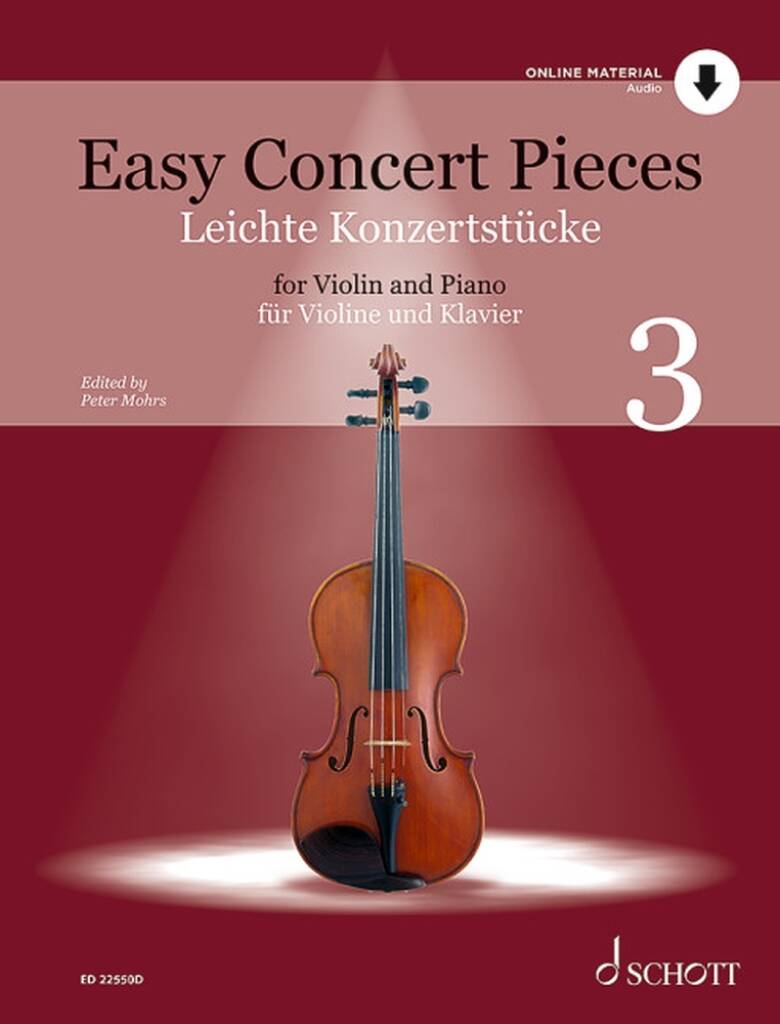Easy Concert Pieces - Violin Volume 3
16 Famous Pieces from 4 Centuries
Imported and often ships in 2-3 weeks, but may take up to three months.
- Editor: Peter Mohrs
- Format: Book with Audio Access
- Instrumentation: Piano, Violin
- ISMN:
Description
The "Easy Concert Pieces" series for Violin and Piano is intended for tuition purposes and are particularly suitable for performance at auditions and school concerts, for competitions, examinations - and for music making at home too, of course. Recordings and backing tracks for all the pieces are included on the accompanying Audio-Download. Volume 3 (intermediate) requires familiarity with the first four positions. Besides well-known works such as the famous Air by Bach, the Largo from Handel's opera ‘Xerxes' and a movement from Vivaldi's Four Seasons, there are rewarding concerto and sonata movements by Küchler and Fiocco, as well as less familiar Romantic compositions by Rieding and Trowell. Modern music is represented in two lovely pieces by Hermann Schroeder, also inspired by the theme of the seasons. Young violinists will enjoy the four pop pieces that round off the selection.
Contents:
- J.S. Bach: Air fromOrchestral Suite No. 3 (BWV 1068)
- G.F. Handel: Largo from Xerxes
- F. Küchler: Concertino in the style of A. Vivaldi, Op. 15 (Allegro moderato
- Siciliano
- Allegro assai)
- A. Vivaldi: Largo fromThe Four Seasons (Winter)
- A. Vivaldi: Allegro from Concerto in G Major, Op. 3, No. 3
- J.-H. Fiocco: Allegro
- O. Rieding: Gypsies' March, Op. 23, No. 2
- A. Trowell: Irish Lullaby, Op. 49, No. 2
- H. Schroeder: Autumn Melody from The four Seasons
- H. Schroeder: Winter Storm from The four Seasons
- P. Mohrs: Meditation
- J. Johow: Hello Violin
- G. Koeppen: Yellow Bossa
- D. Kemminer: Unlucky Fellow
Publishers use a lot of words to describe what they sell, and we know it can be confusing. We've tried to be as clear as possible to make sure you get exactly what you are looking for. Below are descriptions of the terms that we use to describe the various formats that music often comes in.
Choral Score
A score for vocalists that only contains the vocal lines. The instrumental parts are not there for reference. Generally, cheaper than a vocal score and requires multiple copies for purchase.
Facsimile
Reproductions of the original hand-written scores from the composer.
Full Score
For ensemble music, this indicates that the edition contains all parts on a single system (there are not separate parts for each player). In larger ensembles, this is for the conductor.
Hardcover
Hardbound. Generally either linen-covered or half-leather.
Orchestral Parts
Similar to a wind set, this is a collection of parts. In the case of strings, the numbers listed are the number of copies included, though generally these are available individually (often with minimum quantities required).
Paperback
When publishers offer multiple bindings (e.g. hardcover) or study scores, this is the "standard" version. If you're planning to play the music, this is probably what you want.
Performance / Playing Score
A score of the music containing all parts on one system, intended for players to share. There are not separate parts for each player.
Set of Parts
For ensemble music, this indicates that there are separate individual parts for each player.
Solo Part with Piano Reduction
For solo pieces with orchestra, this is a version that contains a piano reduction of the orchestra parts. For piano pieces, two copies are typically needed for performance.
Study Score
A small (think choral size) copy of the complete score meant for studying, and not playing. They make great add-ons when learning concertos and small chamber works.
Vocal Score
A score prepared for vocalists that includes the piano/organ part or a reduction of the instrumental parts.
Wind Set
For orchestral music, this is a collection of wind and percussion parts. The specific quantities of each instrument are notated.
With Audio
In addition to the printed music, the edition contains recordings of the pieces. This may be an included CD, or access to files on the internet.
With / Without Fingering (Markings)
Some publishers prepare two copies - a pure Urtext edition that includes no fingering (or bowing) suggestions and a lightly edited version that includes a minimal number of editorial markings.


